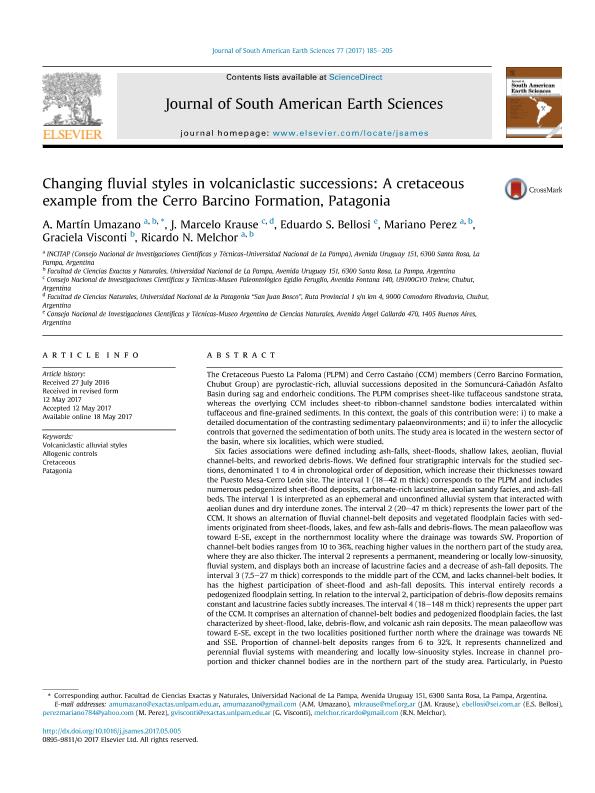Artículo
Changing fluvial styles in volcaniclastic successions: A cretaceous example from the Cerro Barcino Formation, Patagonia
Umazano, Aldo Martin ; Krause, Javier Marcelo
; Krause, Javier Marcelo ; Bellosi, Eduardo Sergio
; Bellosi, Eduardo Sergio ; Perez, Mariano
; Perez, Mariano ; Visconti, Graciela; Melchor, Ricardo Nestor
; Visconti, Graciela; Melchor, Ricardo Nestor
 ; Krause, Javier Marcelo
; Krause, Javier Marcelo ; Bellosi, Eduardo Sergio
; Bellosi, Eduardo Sergio ; Perez, Mariano
; Perez, Mariano ; Visconti, Graciela; Melchor, Ricardo Nestor
; Visconti, Graciela; Melchor, Ricardo Nestor
Fecha de publicación:
08/2017
Editorial:
Pergamon-Elsevier Science Ltd
Revista:
Journal of South American Earth Sciences
ISSN:
0895-9811
Idioma:
Inglés
Tipo de recurso:
Artículo publicado
Resumen
The Cretaceous Puesto La Paloma (PLPM) and Cerro Castaño (CCM) members (Cerro Barcino Formation, Chubut Group) are pyroclastic-rich, alluvial successions deposited in the Somuncurá-Cañadón Asfalto Basin during sag and endorheic conditions. The PLPM comprises sheet-like tuffaceous sandstone strata,whereas the overlying CCM includes sheet-to ribbon-channel sandstone bodies intercalated within tuffaceous and fine-grained sediments. In this context, the goals of this contribution were: i) to make a detailed documentation of the contrasting sedimentary palaeonvironments; and ii) to infer the allocycliccontrols that governed the sedimentation of both units. The study area is located in the western sector of the basin, where six localities, which were studied. Six facies associations were defined including ash-falls, sheet-floods, shallow lakes, aeolian, fluvial channel-belts, and reworked debris-flows. We defined four stratigraphic intervals for the studied sections, denominated 1 to 4 in chronological order of deposition, which increase their thicknesses towardthe Puesto Mesa-Cerro Leon site. The interval 1 (18-42 m thick) corresponds to the PLPM and includes numerous pedogenized sheet-flood deposits, carbonate-rich lacustrine, aeolian sandy facies, and ash-fall beds. The interval 1 is interpreted as an ephemeral and unconfined alluvial system that interacted withaeolian dunes and dry interdune zones. The interval 2 (20-47 m thick) represents the lower part of the CCM. It shows an alternation of fluvial channel-belt deposits and vegetated floodplain facies with sediments originated from sheet-floods, lakes, and few ash-falls and debris-flows. The mean palaeoflow wastoward E-SE, except in the northernmost locality where the drainage was towards SW. Proportion of channel-belt bodies ranges from 10 to 36%, reaching higher values in the northern part of the study area, where they are also thicker. The interval 2 represents a permanent, meandering or locally low-sinuosity, fluvial system, and displays both an increase of lacustrine facies and a decrease of ash-fall deposits. The interval 3 (7.5-27 m thick) corresponds to the middle part of the CCM, and lacks channel-belt bodies. It has the highest participation of sheet-flood and ash-fall deposits. This interval entirely records apedogenized floodplain setting. In relation to the interval 2, participation of debris-flow deposits remains constant and lacustrine facies subtly increases. The interval 4 (18-148 m thick) represents the upper part of the CCM. It comprises an alternation of channel-belt bodies and pedogenized floodplain facies, the last characterized by sheet-flood, lake, debris-flow, and volcanic ash rain deposits. The mean palaeoflow was toward E-SE, except in the two localities positioned further north where the drainage was towards NE and SSE. Proportion of channel-belt deposits ranges from 6 to 32%. It represents channelized and perennial fluvial systems with meandering and locally low-sinuosity styles. Increase in channel proportion and thicker channel bodies are in the northern part of the study area. Particularly, in Puesto Mesa-Cerro Leon locality this interval is the thickest and has the highest proportion of thicker channel belt bodies. We interpret these changes in facies architecture as the response to alternated periods of high (intervals 1 and 3) and low (intervals 2 and 4) primary pyroclastic sediment supply. Moreover, there was a climatic change to wetter conditions (intervals 1 to 2e4); as well as intrabasinal tectonic activity in northern area for intervals 2 and 4 inferred from palaeocurrent data.
Palabras clave:
Volcaniclastic Alluvial Styles
,
Allogenic Controls
,
Cretaceous
,
Patagonia
Archivos asociados
Licencia
Identificadores
Colecciones
Articulos(INCITAP)
Articulos de INST.D/CS D/L/TIERRA Y AMBIENTALES D/L/PAMPA
Articulos de INST.D/CS D/L/TIERRA Y AMBIENTALES D/L/PAMPA
Articulos(SEDE CENTRAL)
Articulos de SEDE CENTRAL
Articulos de SEDE CENTRAL
Citación
Umazano, Aldo Martin; Krause, Javier Marcelo; Bellosi, Eduardo Sergio; Perez, Mariano; Visconti, Graciela; et al.; Changing fluvial styles in volcaniclastic successions: A cretaceous example from the Cerro Barcino Formation, Patagonia; Pergamon-Elsevier Science Ltd; Journal of South American Earth Sciences; 77; 8-2017; 185-205
Compartir
Altmétricas



